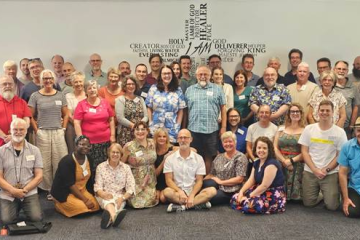Do you know what an earworm is? That song or bit of a song that gets stuck in your brain. Having grown up in the church, it is very hard to read this passage in Acts without that line, “walking and leaping and praising God” repeating and repeating in my head! (And I’m sorry! After today’s service you might be stuck with it too!)
But pushing past that, it is interesting to look at what this story communicates to the early church. That the ministry of Jesus goes on in the ministry of his disciples. This story of healing a man with disability builds on Luke 5:17-26 where Jesus heals a man with disability, and later in Acts 14:8-10 where Paul also does the same. And this ministry – ministry that restores personhood – leads to Peter’s sermon, verses 12 to 26, which is turn leads to Peter and John being arrested and their trial before the entire gathered religious establishment which we looked at last week. This passage tells the church that witnessing to “the time of universal restoration that God [has] announced” (verse 21) involves doing God’s restoring work, proclaiming God’s restoring work, and suffering for doing and proclaiming God’s restoring work – as Jesus did. That through doing, proclaiming, and suffering, God’s restoring work goes on.
I have also been challenged this week, thinking about God’s ongoing restoring work, in the context of a story about a man with disability being healed, in a country where more than 4 million people, 18% or 1 in 5 Australians, have disability. I found it challenging, writing this sermon, to avoid language that is ableist (i.e. we no longer use the words lame or crippled to describe people with disability) and to re-think my ableist theology (or expression of that theology). What does universal restoration, universal restoration, mean for people with disability and people without visible disability?
One of the intriguing features of this passage, despite there being a lot of “walking and leaping and praising God” is its references to sight; Peter and John ‘look intently’ at the man, they ask the man to ‘look at us’ and he ‘fixes his attention on them’ and, finally, the crowd ‘stare’ at Peter and John and the man. And I want use these (though there’s an obvious irony in a discussion of disability) to advance an understanding of universal restoration that is more universal! I want to use these as metaphors for seeing – truly seeing – one other’s personhood in Christ; for asking people to see both disabled and non-disabled people as made in God’s image and models of Christian discipleship, and for directing our gaze to Jesus, who is “the Author of life”, verse 15 tells us, “whom God raised from the dead” – the archetype of restoration.
So, firstly, verses 3 and 4, “When the man with disability saw Peter and John about to go into the temple, he asked them for alms…[and] Peter [we’re told] looked intently at him, as did John…” Before anything dramatic or miraculous occurs in this passage, Peter and John have done something that seems important. They have looked at this man. They have paid attention to who he is and what his needs are.
This week I read a fascinating article by a BBC journalist, Damon Rose, who is blind. “From time to time,” he writes, “without warning or encouragement, I get approached in the street by Christians who tell me they want to pray for me to get my sight back.” He is not religious, he says, so he set about interviewing Christians who are disabled to see, “what Christianity has to offer disabled people beyond promises of miracle cures”.
One of his interviewees is Rev Zoe Heming, a Church of England vicar, and part-time wheelchair user who lives with chronic pain. She also has experiences other Christians, sometimes complete strangers, offering prayer for healing and says she finds this approach can be ‘spiritually abusive’. “I’ve been in situations,” she says, “where I’ve been talking to another wheelchair user in church, and [a person] was so determined to pray for us [despite neither of us inviting it]. In the end he just put his arms on both our shoulders and just prayed.” It was, she says, infuriating and disempowering.
In another UK article, Linn Davies, who is blind, also spoke about faith healing being forced on her a few times and being told that the devil had made her this way. [The thing is, she says,] “the view I have of myself doesn’t match up with the view the general public has of me. I see a multi-talented, well-educated, and high-achieving woman, while they see the blindness above anything else… I see people as unique individuals who bring their strengths to the body of the Church. I’m not against healing, but I have come to understand that it doesn’t mean getting rid of a disability or curing someone. You heal from a break-up, or a cold, or a difficult childhood, but you don’t necessarily heal from being disabled. The path to true healing is being accepted for who you are.”
Peter and John’s attention to the man does lead, in the passage, to healing, but this healing is also visible evidence of a more wholistic healing, a restoration to community, of inclusion in the body of Christ.
Dom Whitting is a hospital chaplain who was born with mild cerebral palsy. He echoes Davies’ words about the path to true healing being accepted for you are. “I believe God can use anyone to do anything and so my prayer is that all churches would be inclusive places for people with disabilities. A warm welcome is just the first step. I hope also that there will be greater understanding about all disabilities, not just physical ones – disability comes in many forms.”
Secondly, having paid attention to the man, Peter and John, say to him, “Look at us.” They invite him into relationship, “what I have I give you”, a relationship based not on a financial exchange, but on having the same name, sharing in the name of Jesus.
Dom Whitting says that from an early age, he felt a calling to be a priest. Wonderfully this was encouraged and supported by many. In 2010 he was ordained in the Church of England and ministered as a curate and then went on to be vicar of two churches. He also had responsibility for a Methodist church and congregation, and he now ministers. as a hospital chaplain. “It is,” he says, “a job I love that I feel God had prepared for me all along… It means I give something back to the NHS, which has been there for me, especially when I was growing up. It also means I get to journey alongside people when life is difficult. In some small way I can relate to their situations. I continue to be amazed at how God often places me at the right time in the right place with the right words to say. In such moments, I’m always thankful for how God has called me and how he continues to use me.”
Reading these articles about Christians with disability, they are saying, like Peter and John, “Look at us!” Look us not because we have it all together. Not because we are successful. Not because we have ‘silver and gold’ but because we share in the ministry of Jesus. What we have we give to you because we share the name of Jesus Christ.
And, thirdly, like Peter in his sermon, they direct people’s attention to Jesus, to the restoring work of God in our world. “Why do you stare at us,” Peter says [or for that matter at this man], “as though by our own power of piety we had made him walk? …the faith that is through Jesus has given him this perfect health in the presence of all of you.”
The same word that described how Peter and John looked at the man is used here for how the crowd are looking at Peter and John. It appears in several places in Acts, at Jesus’ ascension and when Stephen becomes the first Christian martyr, to describe an almost trance-like encounter with transcendent glory.
I like that idea that when Peter and John first see this man with a disability, they see already the transcendent glory of Christ. People with disability point us to Christ. As Dom Whitting says, “I’m always thankful for how God has called me and how he continues to use me.” As Linn Davies says, “I see people as unique individuals who bring their strengths to the body of the Church.”
In the words of Rev Zoe Heming, “I can’t believe it took me this long to realise it, but when Jesus rose from the dead, his risen body still had scars. It was profound for me to realise that the most powerful symbol of the disabled body in the Christian story is his… [He was raised up from the dead] better than perfect. He wore his scars because they told his story. That’s the Jesus that I find in Christianity, not the one that wants to normalise everybody.”
I want to let Zoe have the last word – so I am going to show you a 4-minute video of her ministry in a moment.
As we think about this passage – about the restoring work of God which we are now privileged to share, may we see people in a way that restores their personhood, may we celebrate the way each of us continue the ministry of Jesus, and may we together be witnesses, by faith in his name, to this better than perfect Jesus who came to restore us to each other and to him. Amen.
https://www.youtube.com/watch?v=fK75pRC96LU
Categories:


